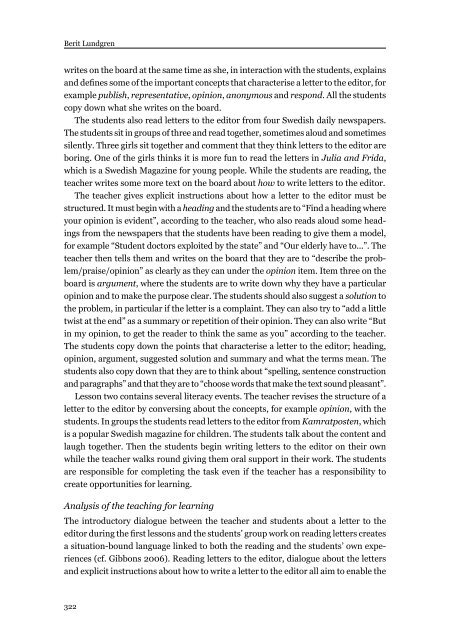Download issue - Umeå universitet
Download issue - Umeå universitet
Download issue - Umeå universitet
Create successful ePaper yourself
Turn your PDF publications into a flip-book with our unique Google optimized e-Paper software.
Berit Lundgren<br />
writes on the board at the same time as she, in interaction with the students, explains<br />
and defines some of the important concepts that characterise a letter to the editor, for<br />
example publish, representative, opinion, anonymous and respond. All the students<br />
copy down what she writes on the board.<br />
The students also read letters to the editor from four Swedish daily newspapers.<br />
The students sit in groups of three and read together, sometimes aloud and sometimes<br />
silently. Three girls sit together and comment that they think letters to the editor are<br />
boring. One of the girls thinks it is more fun to read the letters in Julia and Frida,<br />
which is a Swedish Magazine for young people. While the students are reading, the<br />
teacher writes some more text on the board about how to write letters to the editor.<br />
The teacher gives explicit instructions about how a letter to the editor must be<br />
structured. It must begin with a heading and the students are to “Find a heading where<br />
your opinion is evident”, according to the teacher, who also reads aloud some headings<br />
from the newspapers that the students have been reading to give them a model,<br />
for example “Student doctors exploited by the state” and “Our elderly have to...”. The<br />
teacher then tells them and writes on the board that they are to “describe the problem/praise/opinion”<br />
as clearly as they can under the opinion item. Item three on the<br />
board is argument, where the students are to write down why they have a particular<br />
opinion and to make the purpose clear. The students should also suggest a solution to<br />
the problem, in particular if the letter is a complaint. They can also try to “add a little<br />
twist at the end” as a summary or repetition of their opinion. They can also write “But<br />
in my opinion, to get the reader to think the same as you” according to the teacher.<br />
The students copy down the points that characterise a letter to the editor; heading,<br />
opinion, argument, suggested solution and summary and what the terms mean. The<br />
students also copy down that they are to think about “spelling, sentence construction<br />
and paragraphs” and that they are to “choose words that make the text sound pleasant”.<br />
Lesson two contains several literacy events. The teacher revises the structure of a<br />
letter to the editor by conversing about the concepts, for example opinion, with the<br />
students. In groups the students read letters to the editor from Kamratposten, which<br />
is a popular Swedish magazine for children. The students talk about the content and<br />
laugh together. Then the students begin writing letters to the editor on their own<br />
while the teacher walks round giving them oral support in their work. The students<br />
are responsible for completing the task even if the teacher has a responsibility to<br />
create opportunities for learning.<br />
Analysis of the teaching for learning<br />
The introductory dialogue between the teacher and students about a letter to the<br />
editor during the first lessons and the students’ group work on reading letters creates<br />
a situation-bound language linked to both the reading and the students’ own experiences<br />
(cf. Gibbons 2006). Reading letters to the editor, dialogue about the letters<br />
and explicit instructions about how to write a letter to the editor all aim to enable the<br />
322

















